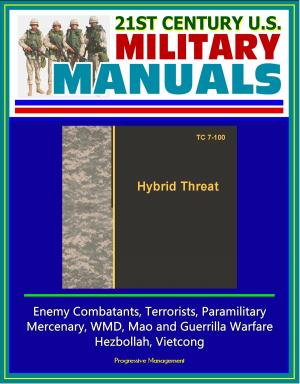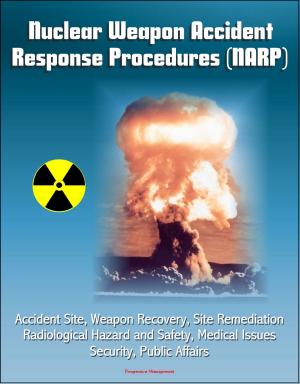21st Century U.S. Military Manuals: The United States Army Functional Concept for Mission Command 2016-2028 - TRADOC 525-3-3 - Intertheater and Intratheater Maneuver (Professional Format Series)
Nonfiction, History, Military, Strategy| Author: | Progressive Management | ISBN: | 9781301851362 |
| Publisher: | Progressive Management | Publication: | December 1, 2012 |
| Imprint: | Smashwords Edition | Language: | English |
| Author: | Progressive Management |
| ISBN: | 9781301851362 |
| Publisher: | Progressive Management |
| Publication: | December 1, 2012 |
| Imprint: | Smashwords Edition |
| Language: | English |
Professionally converted for accurate flowing-text e-book format reproduction, describes broad capabilities the Army will require in 2016-2028 to apply the new doctrine of mission command. This concept will lead force development and modernization efforts by establishing a common framework for capitalizing on mission command in the conduct of future joint land operations and accomplishing missions under conditions of uncertainty and complexity. This concept is the foundation for future force development and for developing future concepts, capability based assessments, Joint Capabilities Integration and Development System documents, experimentation, and doctrine pertaining to mission command. It supports experimentation described in the Army Capabilities Integration Center (ARCIC) Campaign Plan and functions as the conceptual basis for developing solutions to the future force pertaining to mission command across the domains of doctrine, organization, training, materiel, leadership and education, personnel, and facilities (DOTMLPF). This concept applies to all TRADOC, Department of Army (DA), and Army Reserve component activities that develop DOTMLPF requirements.
Chapter 1 * Introduction * 1-1. Purpose * 1-2. Background * 1-3. Assumptions * 1-4. Linkage to the ACC * 1-5. Linkage to the AOC * 1-6. Linkage to the human dimension * 1-7. References * 1-8. Explanations of abbreviations and terms.. * Chapter 2 * Operational Context, Military Problem, Central Idea, and Solution * 2-1. Operational context * 2-2. Military Problem * 2-3. Central idea * 2-4. Military solution * 2-5. Supporting ideas * Chapter 3 * Core Operational Actions * 3-1. Introduction * 3-2. Security force assistance * 3-3. Shaping and entry operations * 3-4. Intertheater and intratheater operational maneuver * 3-5. Full-spectrum operations * 3-6. Overlapping protection * 3-7. Distributed support and sustainment * 3-8. Network-enabled mission command * Chapter 4 * Conclusion * Appendix A * References * Section I * Required References * Section II * Related References * Appendix B * Required Capabilities * B-1. Introduction * B-2. Level 1 * B-3. Level 2 * Appendix C * Mission Command by Echelon * C-1. Introduction * C-2. Theater Army * C-3. Corps * C-4. Division * C-5. Brigade * C-6. Battalion * C-7. Company and below * Glossary * Section I * Abbreviations * Section II * Terms
The U.S. Army continues to answer the Nation's call, as it has since its inception over 235 years ago. As we look to the future, our Army faces a complex and uncertain operational environment that will challenge our Soldiers, leaders, and organizations in many ways. Future enemies are likely to emulate the adaptations of recent opponents while taking advantage of emerging technologies and growing instability to pursue their objectives and avoid what they perceive as U.S. military strengths. The challenges of future armed conflict make it an imperative for our Army to produce leaders and forces that exhibit a high degree of operational adaptability. Confronted by decentralized, networked, and adaptive enemies in complex environments, the Army must redefine its approach to the exercise of authority and direction over its forces. The application of mission command enables commanders to decentralize authority and prevail in three increasingly important dimensions of military operations: the contest of wills, strategic engagement, and the cyber/electromagnetic contest. In support of this approach, TRADOC Pam 525-3-3 serves as a foundation for future force development pertaining to mission command and the mission command warfighting function.
As a bonus, this reproduction includes the complete 2012 Army Leadership manual (FM 6-22), which describes the Army's view of leadership, outlines the levels of leadership.
Professionally converted for accurate flowing-text e-book format reproduction, describes broad capabilities the Army will require in 2016-2028 to apply the new doctrine of mission command. This concept will lead force development and modernization efforts by establishing a common framework for capitalizing on mission command in the conduct of future joint land operations and accomplishing missions under conditions of uncertainty and complexity. This concept is the foundation for future force development and for developing future concepts, capability based assessments, Joint Capabilities Integration and Development System documents, experimentation, and doctrine pertaining to mission command. It supports experimentation described in the Army Capabilities Integration Center (ARCIC) Campaign Plan and functions as the conceptual basis for developing solutions to the future force pertaining to mission command across the domains of doctrine, organization, training, materiel, leadership and education, personnel, and facilities (DOTMLPF). This concept applies to all TRADOC, Department of Army (DA), and Army Reserve component activities that develop DOTMLPF requirements.
Chapter 1 * Introduction * 1-1. Purpose * 1-2. Background * 1-3. Assumptions * 1-4. Linkage to the ACC * 1-5. Linkage to the AOC * 1-6. Linkage to the human dimension * 1-7. References * 1-8. Explanations of abbreviations and terms.. * Chapter 2 * Operational Context, Military Problem, Central Idea, and Solution * 2-1. Operational context * 2-2. Military Problem * 2-3. Central idea * 2-4. Military solution * 2-5. Supporting ideas * Chapter 3 * Core Operational Actions * 3-1. Introduction * 3-2. Security force assistance * 3-3. Shaping and entry operations * 3-4. Intertheater and intratheater operational maneuver * 3-5. Full-spectrum operations * 3-6. Overlapping protection * 3-7. Distributed support and sustainment * 3-8. Network-enabled mission command * Chapter 4 * Conclusion * Appendix A * References * Section I * Required References * Section II * Related References * Appendix B * Required Capabilities * B-1. Introduction * B-2. Level 1 * B-3. Level 2 * Appendix C * Mission Command by Echelon * C-1. Introduction * C-2. Theater Army * C-3. Corps * C-4. Division * C-5. Brigade * C-6. Battalion * C-7. Company and below * Glossary * Section I * Abbreviations * Section II * Terms
The U.S. Army continues to answer the Nation's call, as it has since its inception over 235 years ago. As we look to the future, our Army faces a complex and uncertain operational environment that will challenge our Soldiers, leaders, and organizations in many ways. Future enemies are likely to emulate the adaptations of recent opponents while taking advantage of emerging technologies and growing instability to pursue their objectives and avoid what they perceive as U.S. military strengths. The challenges of future armed conflict make it an imperative for our Army to produce leaders and forces that exhibit a high degree of operational adaptability. Confronted by decentralized, networked, and adaptive enemies in complex environments, the Army must redefine its approach to the exercise of authority and direction over its forces. The application of mission command enables commanders to decentralize authority and prevail in three increasingly important dimensions of military operations: the contest of wills, strategic engagement, and the cyber/electromagnetic contest. In support of this approach, TRADOC Pam 525-3-3 serves as a foundation for future force development pertaining to mission command and the mission command warfighting function.
As a bonus, this reproduction includes the complete 2012 Army Leadership manual (FM 6-22), which describes the Army's view of leadership, outlines the levels of leadership.















